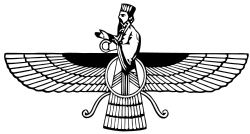Avesta
[6] The Visperad extensions consist mainly of additional invocations of the divinities (yazatas),[7] while the Vendidad is a mixed collection of prose texts mostly dealing with purity laws.
Unlike the Yasna, Visperad and Vendidad, the Yashts and the other lesser texts of the Avesta are no longer used liturgically in high rituals.
[6] The term Avesta originates from the 9th/10th-century works of Zoroastrian tradition in which the word appears as Middle Persian abestāg,[8][9] Book Pahlavi ʾp(y)stʾkʼ.
In that context, abestāg texts are portrayed as received knowledge and are distinguished from the exegetical commentaries (the zand) thereof.
The literal meaning of the word abestāg is uncertain; it is generally acknowledged to be a learned borrowing from Avestan, but none of the suggested etymologies have been universally accepted.
The oldest surviving versions of these tales are found in the ninth to 11th century texts of Zoroastrian tradition (i.e. in the so-called "Pahlavi books").
The legends run as follows: The twenty-one nasks ("books") of the Avesta were created by Ahura Mazda and brought by Zoroaster to his patron Vishtaspa (Denkard 4A, 3A).
[11] Following Alexander's conquest, the Avesta was then supposedly destroyed or dispersed by the Greeks, after they had translated any scientific passages of which they could make use (AVN 7–9, Dk 3B, 8).
[12] Several centuries later, one of the Parthian emperors named Valaksh (one of the Vologases) supposedly then had the fragments collected, not only of those that had previously been written down, but also of those that had only been orally transmitted (Dk 4C).
[13] Tansar's work was then supposedly completed by Adurbad Mahraspandan (high priest of Shapur II, r. 309–379 CE) who made a general revision of the canon and continued to ensure its orthodoxy (Dk 4F, AVN 1.12–1.16).
[15] Texts of the Avesta became available to European scholarship comparatively late, thus the study of Zoroastrianism in Western countries dates back to only the 18th century.
[16] Abraham Hyacinthe Anquetil-Duperron travelled to India in 1755, and discovered the texts among Indian Zoroastrian (Parsi) communities.
According to the theory of Friedrich Carl Andreas (1902), the archaic nature of the Avestan texts was assumed to be due to preservation via written transmission, and unusual or unexpected spellings in the surviving texts were assumed to be reflections of errors introduced by Sasanian-era transcription from the Aramaic alphabet-derived Pahlavi scripts.
[n 1] The search for the 'Arsacid archetype' was increasingly criticized in the 1940s and was eventually abandoned in the 1950s after Karl Hoffmann demonstrated that the inconsistencies noted by Andreas were actually due to unconscious alterations introduced by oral transmission.
[23] Based on linguistic aspects, scholars like Kellens, Skjærvø and Hoffman have also identified a number of distinct phases, during which different parts of the Avestan corpus were composed, transmitted in either fluid or fixed form, as well as edited and redacted.
[30] Due to a number of geographical references, there is a wide consensus that they were composed in the eastern portion of Greater Iran.
[33] The subsequent transmission took largely place in Western Iran as evidenced by alterations introduced by native Persian speakers.
[26] It was not until around the 5th or 6th century CE that Avestan corpus was committed to written form, which lead to the creation of the Sasanian Avesta.
[39] The surviving texts of the Avesta, as they exist today, derive from a single master copy produced by that collation.
[6] Only about one-quarter of the Avestan sentences or verses referred to by the 9th/10th century commentators can be found in the surviving texts.
In its present form, the Avesta is a compilation from various sources, and its different parts date from different periods and vary widely in character.
Both its extant as well as historical manuscripts seem to have consisted of the Avestan text jointly with translations, commentaries, glosses and instructions in Middle Persian.
Of these nasks, the Stod-yasn is extant in the Staota Yesnya, which forms the central portion of the High Liturgies like the Yasna and Visperad (see below).
The Yasna (from yazišn "worship, oblations", cognate with Sanskrit yajña), is the primary liturgical collection, named after the ceremony at which it is recited.
The Vendidad (or Vidēvdāt, a corruption of Avestan Vī-Daēvō-Dāta, "Given Against the Demons") is an enumeration of various manifestations of evil spirits, and ways to confound them.
Fargards 4 and 15 discuss the dignity of wealth and charity, of marriage and of physical effort and the indignity of unacceptable social behaviour such as assault and breach of contract, and specify the penances required to atone for violations thereof.
The Vendidad originally was one of the legal nasks of the Sasanian Avesta and therefore, unlike the Yasna and the Visparad, is a text dealing with laws rather than the record of a liturgical ceremony.
However, the text is used within the so called Videvdat ceremony, in which the Yasna is recited with all the chapters of both the Visparad and the Vendidad inserted at appropriate points.
The Siroza is never recited as a whole, but is a source for individual sentences devoted to particular divinities, to be inserted at appropriate points in the liturgy depending on the day and the month.



